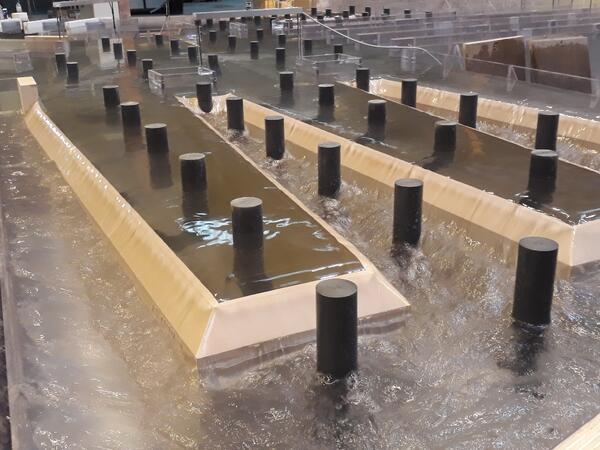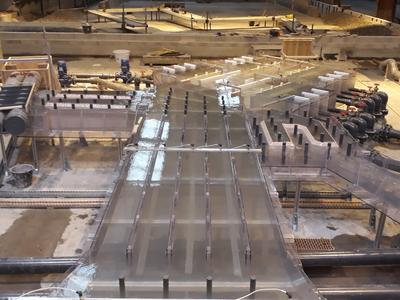
New water supply structures at Achères wastewater treatment plant
Artelia used its laboratory to perform hydraulic modelling on the project to reconfigure the world’s second largest wastewater treatment plant, the Seine Aval plant in Achères to the west of Paris.
Context

Distribution and lift pumping station at Achères - Seine Aval wastewater treatment plant (France) - Client: Hydratec - Scale: 1:12
This model was exceptional in terms of its size, its electronic equipment (automated measuring and control instrumentation) and the way it was operated, simulating sudden pump shutdowns generating load rejection surges.
- 11 electromagnetic flowmeters,
- 22 ultrasonic water level sensors,
- 7 pilot valves for reproducing fast unsteady flows with a high level of accuracy,
- models of 16 volute pumps (DN 700) for a total pumped flow rate of 34 m3/s. With the outlets to the other parts of the station, the model represented a total ingoing flow rate of 70 m3/s
Ambitious objectives for this complex model
 Calibrate the model boundary conditions, on the upstream and downstream sides
Calibrate the model boundary conditions, on the upstream and downstream sides- Study the water level profiles and flow distributions for the many possible operating conditions
- Ensure that the flow distribution through the open-channel flow meter is satisfactory, with the aim of quantifying daily wastewater inflows entering the treatment plant
- Study the flow conditions to ensure an efficient water supply to the pumps (surface and bottom vortices, pre-rotation in the flow at the pump inlets)
- Characterise and optimise the dimensional design of the emergency overflow weirs (labyrinth weirs)
- Study transient phenomena related to electrical tripping of pumps with a high level of accuracy: faithfully represent flow cutoff and monitor the load rejection surge in time and space
- Check the behaviour of floating debris in order to ensure that it is released by opening surface flap gates.
